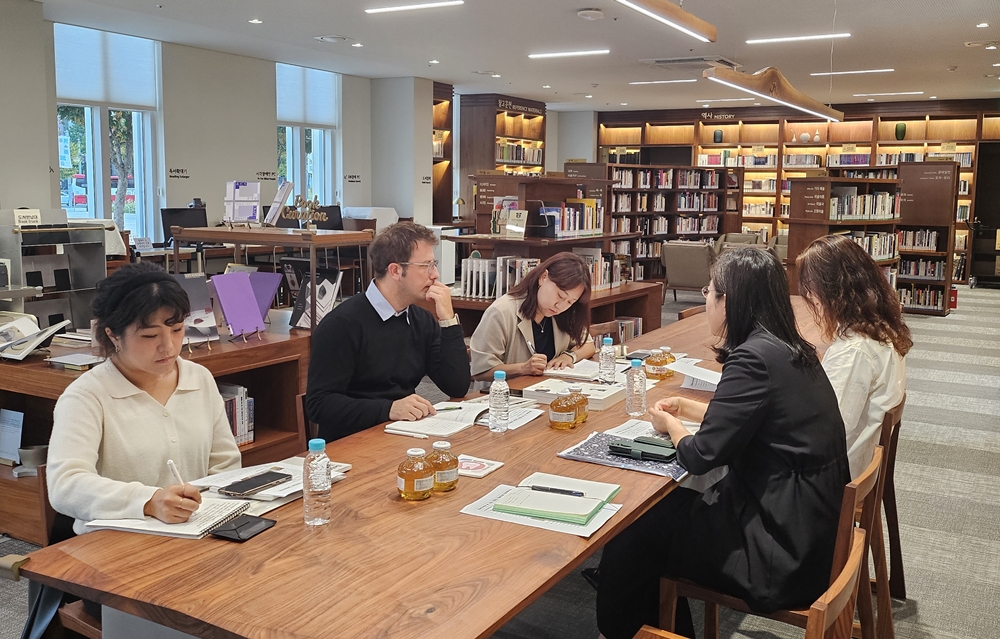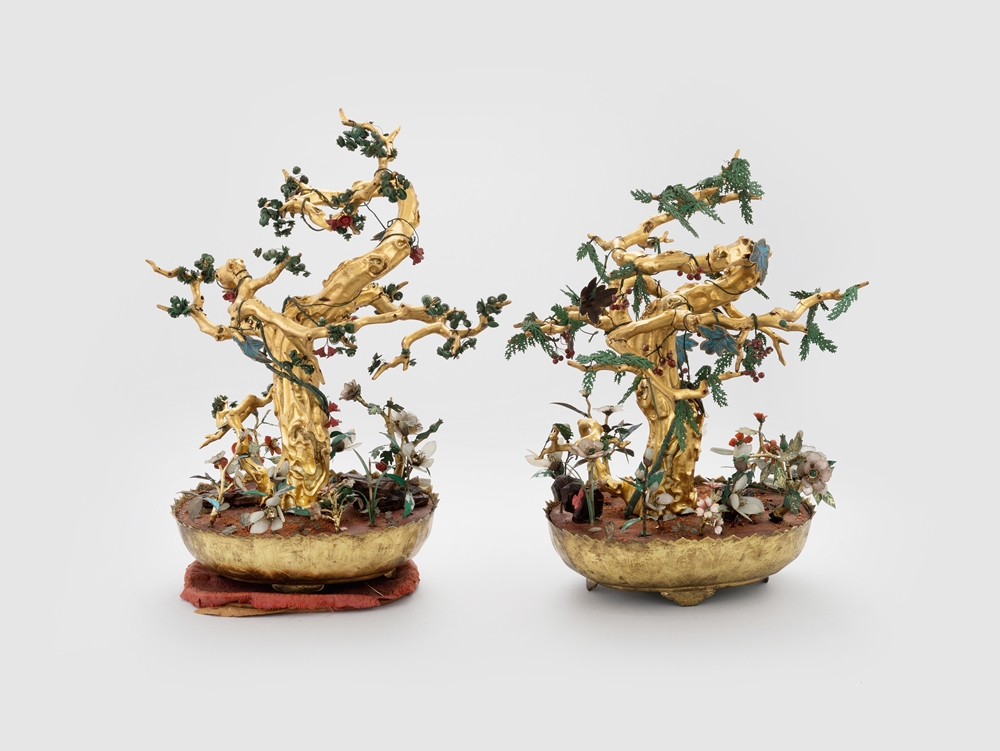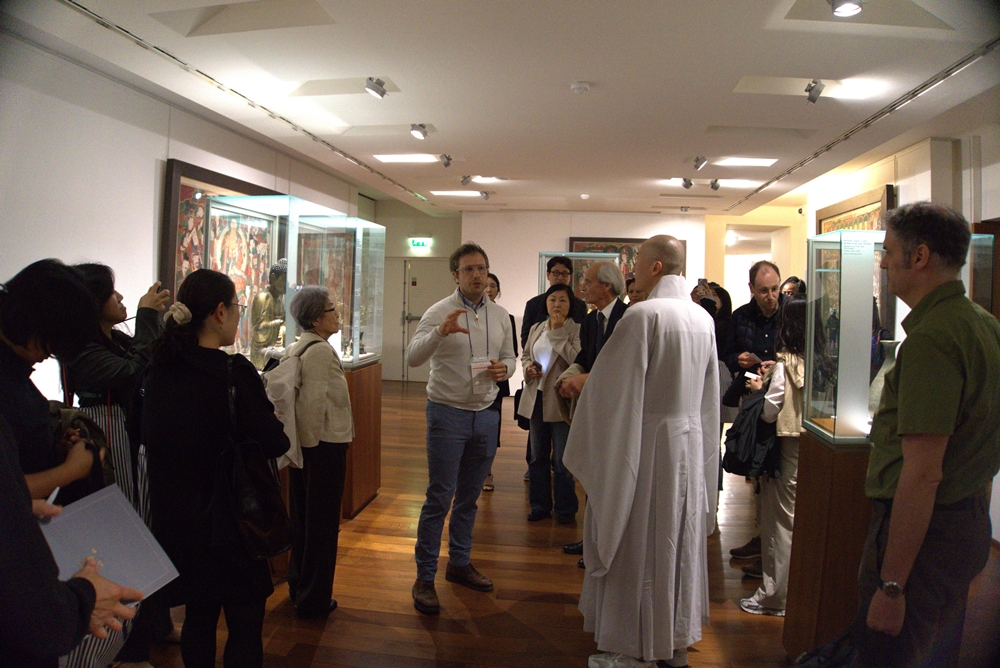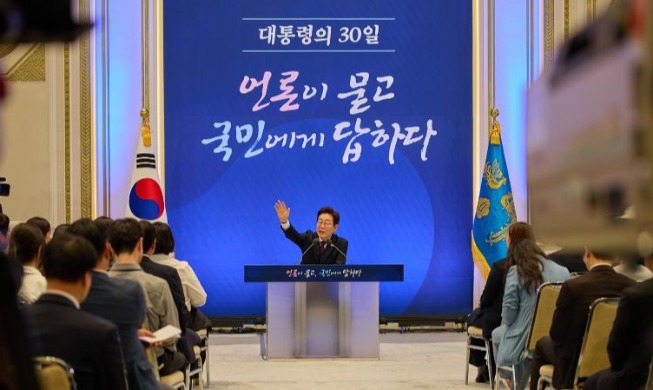- 한국어
- English
- 日本語
- 中文
- العربية
- Español
- Français
- Deutsch
- Pусский
- Tiếng Việt
- Indonesian
The Ministry of Culture, Sports and Tourism's K-Fellowship invites leading foreign figures to Korea to promote the global exchange of culture and arts. Launched in 2009, the program marks its 16th edition this year.
Over 200 representatives from cultural and arts institutions worldwide have visited Korea through the fellowship to discover and promote exchange and joint projects with domestic entities and experts.
This year, 15 such people from 15 countries recommended by Korean Cultural Centers abroad have been invited. Korea.net on Oct. 2 interviewed Arnaud Bertrand, curator in charge of Korean and ancient Chinese collections at the Guimet Museum in Paris.

Arnaud Bertrand (second from left), curator in charge of Korean and ancient Chinese collections at the Guimet Museum in Paris, and Seoul Museum of Craft Art Director Kim Soo Jeong (second from right) on Sept. 30 talk at the latter museum in Seoul's Jongno-gu District about cooperation. (Seoul Museum of Craft Art)
By Charles Audouin and Gil Kyuyoung
The Guimet Museum located at Iena Square of Paris is the largest facility of its kind for Asian art in Europe. Established in 1889 by French businessman Emile Guimet, the facility displays artifacts from Asian countries such as Korea, China and Japan.
It houses about 1,500 pieces of Korean cultural heritage considered to have the value of national treasures including Goryeo celadon, Silla gold crown and calligraphy by neo-Confucian scholar Yi Hwang from the Joseon Dynasty.
Arnaud Bertrand, curator in charge of Korean and ancient Chinese collections at Guimet, is considered a luminary in Asian art. He teaches art history and archaeology at the school Ecole du Louvre and the Catholic University of Paris and is a writer for the history YouTube channel "Nota Bene," which has 2.5 million subscribers.
The following are excerpts from an Oct. 2 interview with Bertrand in Seoul.
This is your first visit to Korea.
It's as if I came to an American-style Confucian nation. Just looking at the streets filled with cafes clearly shows the Western values that have continued for half a century here. I think that foreign visitors can't help but think that they've come to a Western-style Asian country. There are also traditional, administrative and Confucian characteristics due to the effects of various religions such as Christianity, Buddhism, Taoism and shamanism. I think Korea is so popular now because such values coexist harmoniously.
What is the purpose of your trip?
My visit to Korea was an opportunity to directly experience Korean culture, which I previously accessed through books, art or French fans of Hallyu (Korean Wave) who love K-dramas or K-pop. With people I knew in the art industry, I discussed events to commemorate the 140th anniversary of diplomatic ties between Korea and France. We're planning diverse projects such as music concerts, symposiums, discussions, conferences, research sessions, digitization of collections and improvement of exhibition spaces.
We're also thinking of introducing leading Korean artworks, or rare clothing, literature or apparel in a permanent exhibition. We plan to display works like banhwa (royal ornament), which King Gojong sent as a gift to then French President Sadi Carnot. The latter's son in the 1950s donated the item to the Guimet Museum.
Guimet Museum President Yannick Lintz also visited Korea and attended the conference. Thus the K-Fellowship is an impetus to prepare for 2026, the year marking the launch of diplomacy between Korea and France.

These two banhwa (traditional ornaments) were given by King Gojong as a gift to then French President Sadi Carnot. (Overseas Korean Cultural Heritage Foundation)
Describe the Korean collection at the Guimet Museum.
The Korean collection displays artifacts directly brought by French ambassadors to Korea and symbolizes bilateral friendship. The debut of a Joseon art display in 1893, when the French public was mostly interested in Japan or China, only had folk works.
But now, we must show Korea itself apart from the influence of Japan or China. The role of the collection is to understand Korea's meticulous attention to detail, distinctiveness and technical precision.
How much does the French public know about Korean history and culture?
The Overseas Korean Cultural Heritage Foundation recently released a research report in English on the Korean cultural heritage displayed at the Guimet Museum. But books on Korean art are very rare.
We collaborated with Bordeaux Montaigne University professor Okyang Chae-Duporge, a rare expert on Korean art in France, to set up the first Korean art class in France at the Ecole du Louvre. We sought to offer the opportunity for students to learn about Korean art in depth before 2026. We hope to attract people who love Korean pop culture and those into traditional Korean culture to one place.

Guimet Museum curator Arnaud Bertrand (middle) on Sept. 9 explains Korean cultural heritage at the Korean collection corner of his museum in Paris. (Overseas Korean Cultural Heritage Foundation)
Has French public interest in Korea changed?
Interest in Korea is apparently growing, as we held in September a Chuseok (Korean Thanksgiving) event at the museum. Yet a gap remains between Korea's relatively unknown traditional art and pop culture. At the 2026 exhibition, we plan to show via K-dramas how Korea's pop culture and traditional art are connected.
What is certain is that many foreign nationals are visiting Korea and contemporary art fairs are coming to Seoul, which is gaining attention in economy and culture. 2026 will definitely be different from 2016 because the world is focusing on Korean art.
Any concluding message to Korea.net readers?
You must visit Korea as you cannot fully understand a country's culture via books or videos alone. The leading example is "Squid Game." The scenes in that series are quite different from what is seen on Korean streets. Korea's distinct characteristics is something to be directly experienced like the friendliness and trust among its people.
Personally, I like how Koreans don't care if one is a foreigner or a tourist. As a mere visitor to Korea, I feel so lucky to person to travel around here and there.
caudouin@korea.kr
Most popular
- Grammy-winning producer calls Suga of BTS 'amazing artist'
- Animated 'KPop Demon Hunters' tops Netflix charts in 41 markets
- 'Squid Game' events to pump up K-Content Seoul Travel Week
- Reunited BLACKPINK releases video preview of world tour
- 'Universal love, family' themes fuel success of 'King of Kings': director
